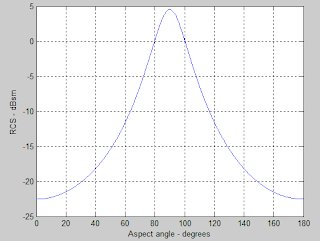We have performed several simulations involving simple shapes such as ellipsoid and cylinder. In this post, we only show the ellipsoid as it is the easiest shape to be studied in order to understand the effect of radar direction to the target's RCS, which is the effective reflective area. If the target's RCS is large, it will be easier for the target to be detected by radar.
 |
| Figure 1. Ellipsoid. (Taken from Mahafza, Bassem R, MATLAB Simulations for Radar Systems Design, CRC Press/Chapman & Hall, 2004.) |
As shown in Figure 1, the direction of receiving radar is represented by the vertical/aspect angle, theta, and the horizontal angle, phi.
First, we simulated the condition where the length b was longer than a, and phi at zero degree. The result was as shown in Figure 2.
 |
| Figure 2. |
Figure 2 shows that the RCS kept increasing when the aspect angle increase, but then started to decrease after 90 degree. In other word, the reflected power was the largest at the middle of the ellipsoid.
Then, we made the radar direction to face the ellipsoid at the direction of y axis by changing phi to 90 degree and the result was as shown in Figure 3.
 |
| Figure 3. |
Figure 3 shows that the maximum RCS has decreased compared to the previous simulation. This was because the reflective surface area by looking at the y axis is smaller compared to x axis.
After that, we made the length a to be equal to length b. Then, we ran the simulation at phi equal to zero and 90 degree and the result for both test was as shown in Figure 4 and Figure 5 respectively.
 |
| Figure 4. |
 | ||||
| Figure 5. |
Figure 4 and Figure 5 shows that the result for both simulation was just the same and target's RCS was no longer affected by the changes of phi. This was because the equal length of a and b caused the reflective surface area to remained the same in any horizontal direction of the radar.
Finally, we set the length of a, b and c to be equal in order to produce a symmetrical sphere as in Figure 6 and the result of the simulation was as shown in Figure 7.
 |
| Figure 6. Sphere. (Taken from Mahafza, Bassem R, MATLAB Simulations for Radar Systems Design, CRC Press/Chapman & Hall, 2004.) |
 |
| Figure 7. |
Figure 7 shows that the RCS remained constant in any vertical or horizontal direction of radar because the reflective surface area of a sphere is the same in any direction.
No comments:
Post a Comment